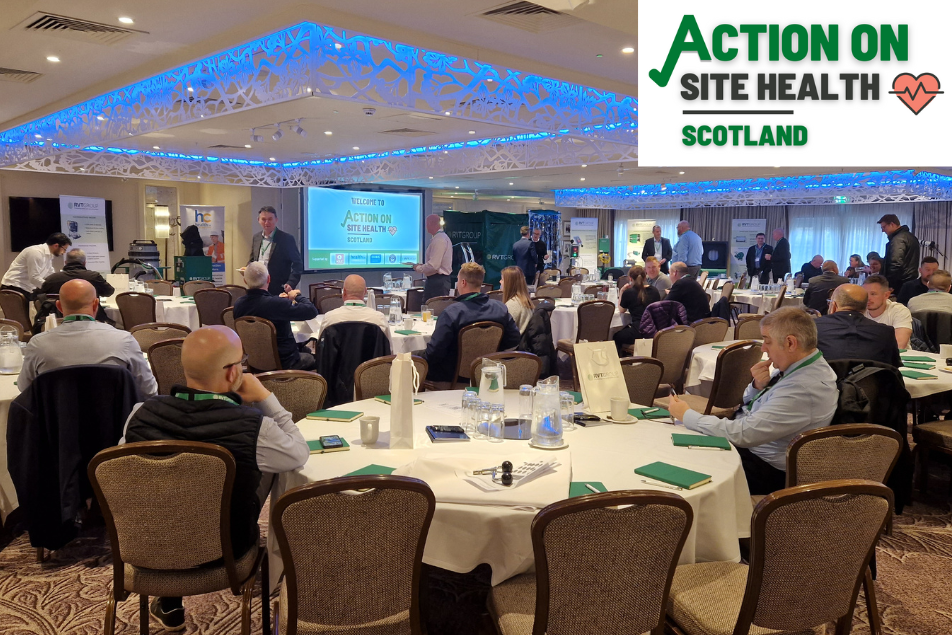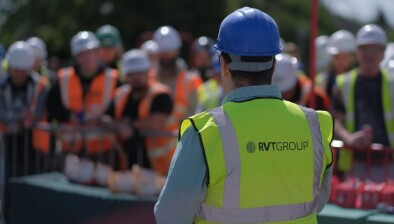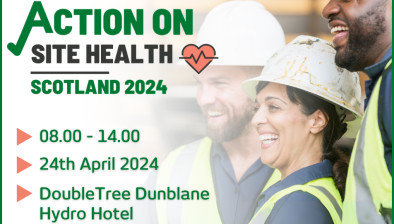RVT shares highlights from Action on Site Health summit

Discussions and lessons learned from a recent Action on Site Health (AOSH) event have been shared by the RVT Group.
The event, which took place on Tuesday 18th April at the Dalmahoy Hotel and Country Club in Edinburgh, gave attendees the opportunity to discuss and learn about important site health topics, with influential guest speakers from the construction and health industry.
The speakers and interactive activities at the event covered a variety of topics from both regulatory and contractor perspectives, including respiratory health, mental health, musculoskeletal disorders and hearing. The experts shared their advice on a common objective; to significantly reduce the number of construction workers suffering from work-related ill-health.
As well as this, RVT wanted to hear about the problems the delegates have experienced and the solutions they would recommend. Opinions did not disappoint, valuable points were made, including “We need to implement more HSE inspections on the ground - to provide us with free advice” and “It is important to educate smaller contractors around the importance of health control on-site “.
As part of the brainstorming session, delegates were asked three thought-provoking questions, and here’s what they had to say:
1. How do we improve health control buy in from smaller contractors who are limited by cost?
There was a variety of strong opinions on this subject, which made a great discussion. A consensus across the room was around educating smaller contractors about the importance of health on site, so if funds are restricted, the health of workers is still treated as a priority. Below are the key points raised by delegates at the event.
Educate smaller contractors about health control standards
It was suggested that common health control standards and expectations across the industry should be reviewed, and an industry focus was needed around educating smaller contractors about industry standards. This included an idea of increasing the number of HSE inspectors on the ground to give advice to smaller contractors on how to manage risks successfully, and to recommend cost-effective heath control solutions. This led to another suggestion about contractors having access to more free advice, whether that is from the HSE or other coaching and professional bodies within the construction industry. Also, advice/guidance should be delivered with more of a receptive stance to encourage better engagement from smaller contractors, for example, ‘We are here to help, not to police”, and there was an idea from another delegate about having a publicity campaign around the topic to achieve a more hard-hitting impact.
Make smaller contractors aware of the benefits/consequences of poor health control
Another key point raised by a delegate was to educate smaller contractors around the benefits of health control on site. If they get it right first time – they are less likely to experience project delays and achieve better staff morale/retention.
The consequences around not having adequate health controls should also be communicated, such as the well-being of workers, financial loss, and that non-compliance with standards could result in a hefty fine and a bad reputation. The feeling amongst delegates was that if smaller contractors were more aware of how health standards could benefit/affect their project and workers, it would encourage better health control choices and budget allocation.

Mandatory health control should be decided at tender stage
It was also raised by a delegate that health control should be made mandatory at tender stage. This way, health and safety is included in the cost, and at the starting point of a project, it is discussed what health hazard control it is essential.
Fairer supply chain
The last point made, is that there should be a fairer supply chain, and that smaller contractors might not receive the same discounts on health control solutions as larger contractors.
2. How do we ensure that clients are factoring health investment into their tendering process?
Allocate health budget at tender stage
A percentage split of the tender assessment should be allocated for health – this includes cost, quality, programme and safety. Also, that it should be stipulated what the health budget is at tender stage. Early planning and design input could also encourage buy-in from the start, as well as reviewing sample build/mock ups prior to design, to get the discussion around health started, in line with HSE guidance.
Educate contractors
As with question number 1, there was a lot of discussion around education, but this time for clients. It was suggested that this could be led by long-standing tier 1 contractors, who can lead a consistent message and set the standards of how important it is for health to be factored into the tendering process. It was emphasised that clients should be educated about their responsibility regarding health on site.
Health targets and financing
Another suggestion was to link health targets to sustainability targets for financing – and finance should be dependent on the health outcomes of a project.
3. How do contractors ensure a minimum health standard is in place on site?
Hazard monitoring
This question raised a lot of opinions regarding hazard monitoring on site. This included the importance of noise, dust, gas and vibration measurements, because this will ensure that the hazard controls in place are adequate. Also, an increase in inspections, spot checks, and audits should be considered – to review the effectiveness of hazard controls and to identify areas for improvements.
Training
Again, it seemed that the overall feeling in the room was around education and training on health standards. Ideas from delegates included apprenticeships, tool box talks, having a training matrix, CPD training and mentoring. Also, that there should be new campaigns around health standards, led by the HSE and the Government, giving clear communication on the expected standards. One delegate expressed the need for more best practice advice, and that mistakes/lessons learned should be shared, just like at this AOSH event.

Health standards should be communicated early
There was a lot of ideas around this key point, including:
- Early engagement of health standards discussed at tender stage/pre-contract
- Modern methods of construction (safer methods) stipulated at design phase
- Pre-construction phase plan communicated early
- Pre-minimum standard of competency agreed
- Practical pre-start meetings to take place to agree and confirm expected health standards
- Pre-RAMS review and sign off
More safety management teams
There should be more site supervision – competent and knowledgeable staff, who have the back up from management to make decisions. Also, health and safety teams should be on the payroll to provide occupational health support. It was mentioned that it is important to have a relationship with companies like RVT Group – who offer advice, support and training.
More site inspections
It would be beneficial to have more routine site inspections to validate that standards are being complied with. It should also be encouraged to report near-miss situations and incidents, as this is an opportunity to learn from mistakes, and create a safer site going forward.
A spokesperson for RVT Group said: “Thank you to our delegates for sharing their thoughts and opinions. It certainly made a lively debate, and a lot of interesting points were made. We were delighted to see so many people gathered with the common goal of working towards better protection for all aspects of site health and a lot of lessons were learned by all.
“We would also like to express a huge thank you to the speakers the supporters and for making this event a great success.”













